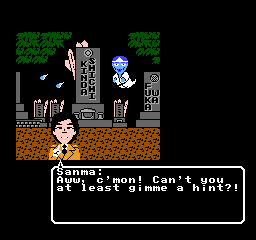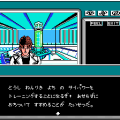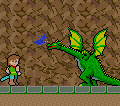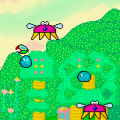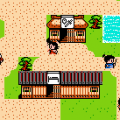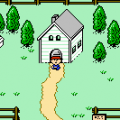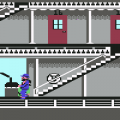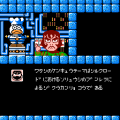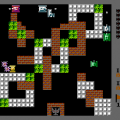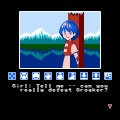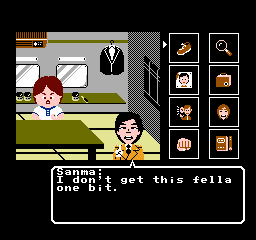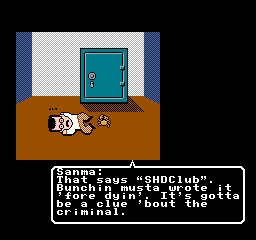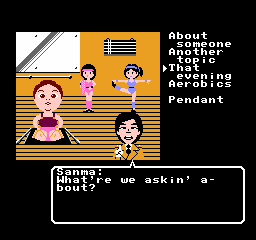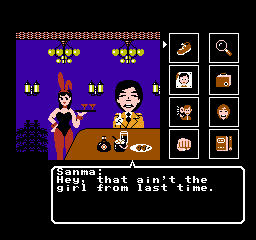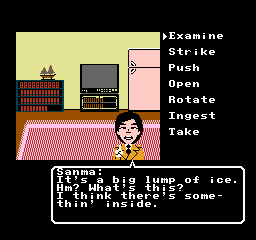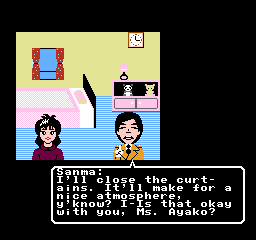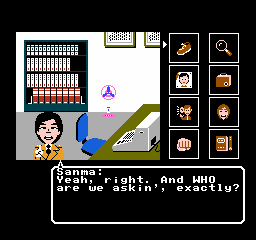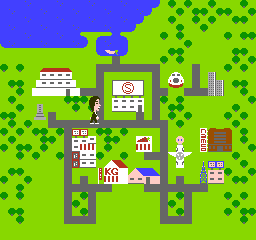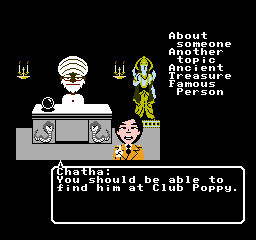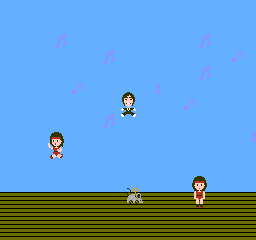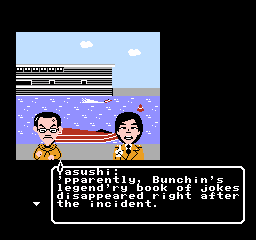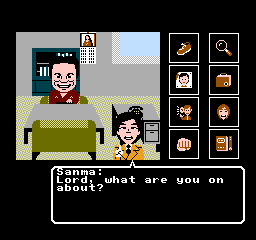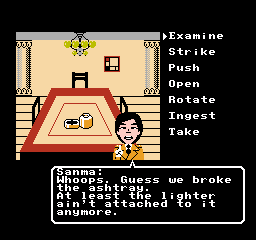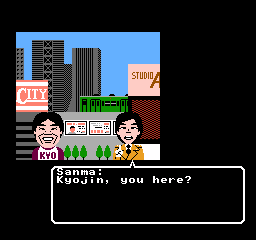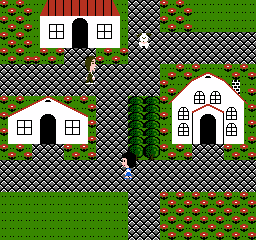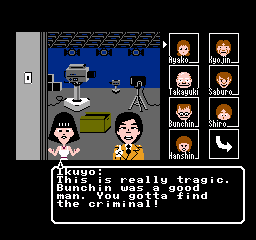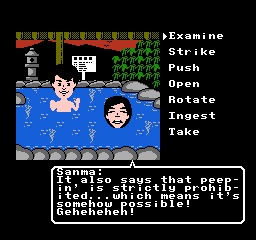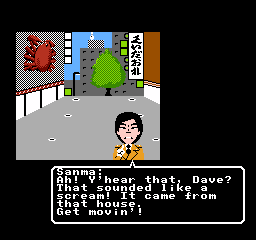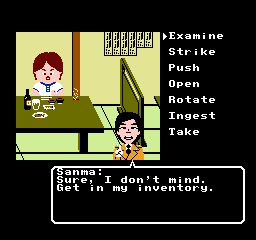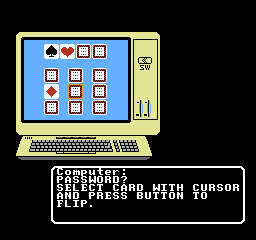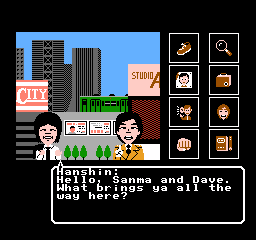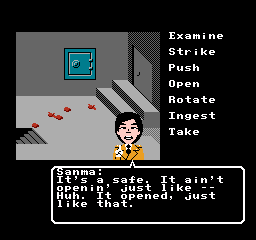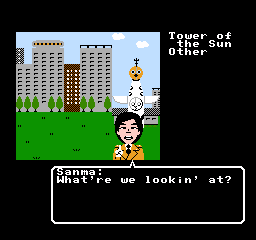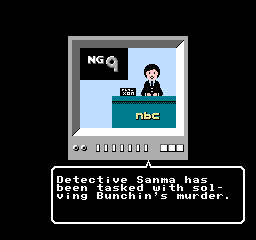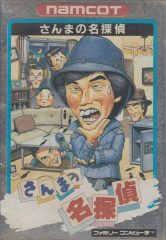
Famicom Cover
Sanma no Meitantei (or “Great Detective Sanma”) is an interesting footnote in the history of early Japanese adventure games. It’s a crossroads of sorts between the release of detective-based murder mysteries inspired by Yuji Horii’s Portopia Renzoku Satsujin Jiken, and – of all things – the Japanese stand-up comedy scene of the mid-80s. This is clear from the get-go, since it stars renowned comedian Sanma Akashiya as the titular great detective, along with a host of famous double acts and comedians of the day who populate the game world.
At a party held in an opulent mansion, Bunchin Katsura is found murdered by the safe, which has been robbed of a diamond called the Star of Africa. You play as the assistant to Detective Sanma, and the two of you must figure out who murdered Bunchin and what happened to the diamond. This won’t be easy as there were eight other people who attended the party, all of whom have some kind of secret to hide.
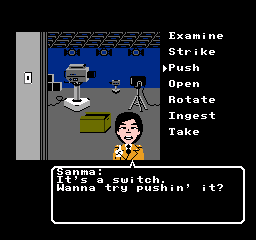
Sanma no Meitantei operates much like your average detective adventure game, where you make progress by gathering information through talking to people, examining the surrounding area, and obtaining objects. Like the Famicom version of Portopia, it uses a menu of commands for you to choose from, though presented through icons instead of words.
Most icons are self-explanatory, such as talking to characters and opening your inventory to present or use items, but others aren’t so much. There’s a list of characters who you can call out if they’re possibly in the area, and a magnifying glass that lets you interact with objects in various ways (objects are selected via a crab cursor). In addition, there’s a notebook that gives you a password to resume the game from in your next session, though the book must be obtained from a nearby graveyard first.
Every now and again, you’ll be presented with a short action sequence where you must complete a task in order to move on. Each sequence plays differently: grabbing the notebook involves dodging falling plates, while another will have you mashing the buttons Track & Field-style to win a boat race. There’s an optional area where you can play a tricky parody of Galaxian called Crabaxian in order to get hints from alien crabs.
These sequences break up the investigation, but are thankfully not too difficult to clear. The game lets you try them as many times as you need, though you will have to repeat the introductory dialogue every time. The Crabaxian parody is a bit too long and hard just to get hints, as you die in one hit and will have to start the whole thing over, but these otherwise do the trick in providing some variety.
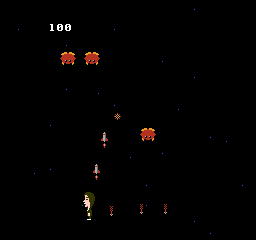
Like Portopia, Sanma presents an open-ended mystery where you have many leads that you could follow up on, and it doesn’t immediately present how you should go about solving it. This is definitely a game for taking notes, because it won’t convey exactly what you should or could do beyond providing information from conversations and items. That lack of conveyance can be frustrating, as it could result in you exhausting every option in each area just to trigger the next part of the game.
Exacerbating this is that, unlike Portopia, there aren’t paths that resolve and can be cleanly disregarded once you’ve gotten to the bottom of them. Characters still matter for most of the game, even if just for finding info on other characters or plotlines. Most of them also move around more, meaning you’ll have to visit new and old locations in order to talk with them or examine areas without their interference. That said, they only move when the plot progresses, so you can rely on them sticking around until you’ve got new leads.
Progression is quite open-ended, allowing you to tackle the various parts of the investigation in whatever order you see fit. Areas can only be explored once you’re told about them, making the early game fairly easy in finding some leads. If you’re stuck on one path, it’s easy to step away and try another one for a while, though the comically convoluted plot makes it hard to keep track of. This provides plenty of freedom to explore, along with an extra degree of challenge and different approaches to solving the mystery on repeat playthroughs.
There’s also a handful of multiple endings to uncover, though these only show their head near the end of the game. There’s only one good ending in which you catch the true culprit, while the rest are the result of deliberately selfish or careless decisions which you can spot. They’re fun goofy endings that fit right in with the ridiculous, light-hearted tone of the rest of the game.
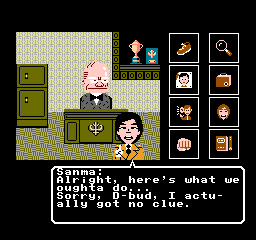
Despite the murder, Sanma no Meitantei doesn’t take itself that seriously. Instead of something more po-faced, you get an adventure where Sanma regularly makes bad jokes, suspects hide stupid secrets like sneaking off to lose weight, and you’re forced to take part in dumb mini-games to find vital pieces of information. Some jokes can be a bit much, particularly Sanma’s attempts to flirt with random ladies including trying to confiscate a young woman’s panties as “evidence”, but there’s a shamelessness that can be charming if you’re in the mood for it.
That also carries through to the presentation. Backgrounds are bright and colourful, while characters are rendered in big-headed caricatures of their real selves (Sanma shows his notoriously large front teeth at all times). The mini-games are clearly presented and easy to read, which helps with clearing them even when action games aren’t your thing. The music creates a handful of whimsical tunes to keep the playful mood up, though their very short length grates during the longer, trickier investigations.
Sanma no Meitantei won’t be for everyone, being a bit too impenetrable at times when making progress and its mini-games might jar for those wanting a pure adventure game. But if you’re prepared to take notes and want something a more open-ended, silly murder-mystery than Portopia, then it’s worth giving the game a look. The game received an English fan translation in 2018 thanks to LIPEMCO! Translations, so it’s very easy to try it out.
It also has something of a cult reputation in Japan. It voted in as the 20th favourite Famicom game amongst Weekly Famitsu readers back in 2003, while fans regularly make in-jokes about the crab icon used for investigation and the variety added by the mini-games. One of the enemies featured in Super Mario RPG even recites the exact phrase Sanma uses when examining objects “kani kani doko kani”, though only in the Japanese version.
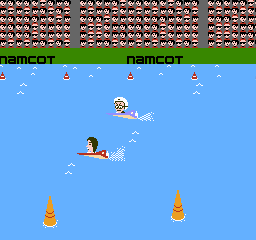
The comedians who appear in Sanma no Meitantei:
![]()
Sanma Akashiya: One of the “Big Three” television comedians of Japan, alongside Beat Takeshi and Tamori. He has been a mainstay of Japanese television since the 1980s, having starred and appeared in many long-running shows – some of which carry his name such as the Appare Sanma series and Odoru! Sanma Goten!!.
![]()
Bunchin Katsura: A rakugoka, or story-teller in the medium of rakugo. He was once part of the TV group “The Panda”, which consisted of other young rakugoka such as Kosome Hiyashida and Kinshin Katsura. He is now a leading performer in the world of Kamigata Rakugo, stories told with a broad Kansai dialect. An example of his performance can be viewed here: https://www.youtube.com/watch?v=su45EfcArTY
![]()
All Hanshin: One half of the duo “All Hanshin Kyojin“, which has been running for nearly 40 years. They deal in the manzai form of stand-up comedy, which involves comedy told through conversation, sometimes interacting with the audience. An example of their performance can be found here: https://www.youtube.com/watch?v=AyGoyP05ar8
![]()
All Kyojin: The other half of “All Hanshin Kyojin“. Another example of their performance can be seen here: https://www.youtube.com/watch?v=U41b25PpF0I
![]()
Saburo Taihei: One half of “Taihei Saburo & Shiro”, an Osaka-style manzai comedy duo who ran from 1976 to 1992. Saburo was Shiro’s most stable comedy partner. They helped popularized manzai as a style of comedy during the 1980s.
![]()
Shiro Taihei: The other half of “Taihei Saburo & Shiro”. After the duo went their separate ways, Shiro unsuccessfully ran in an election for national government, and spent the rest of his career as a solo artist. He also helped to foster the careers of other acts along with restaurants and bars. He passed away in 2012, aged just 55.
![]()
Ikuyo Ima: One half of the comedy duo “Ima Ikuyo Kuruyo“, who ran from 1973 to 2015. A routine of their act was making fun of their respective body sizes (Ikuyo was “the skinny one”, and Kuruyo “the chubby one”). Ikyuo passed away in 2015 from stomach cancer, aged just 67. An example of their act can be watched here: https://www.youtube.com/watch?v=yPFQ8wRkWR4
![]()
Kuruyo Ima: The other half of “Ima Ikuyo Kuruyo“, who were influential in the stand-up comedy scene of the 1980s. Their stage names were based on the phrases Ima Ikuyo (“I’m going now”) and Ima Kuruyo (“I’m coming now”) respectively. Another example of their act can be viewed here: https://www.youtube.com/watch?v=NtvKkfjqp5c
![]()
Shinsuke Shimada: A comedian and television presenter, started as a stand-up comic in the late 70s before going on to present variety shows and political discussion programmes. He retired in 2011 following allegations that he had links with the yakuza, something he admitted to just before an exposé from a popular weekly magazine on the subject was to be published.
![]()
Norio Nishikawa: A comedian of the manzai variety. He voiced Tetsu Takemoto in the film and TV adaptations of the manga Jarinko Chie, or Chie the Brat, most of which were directed by famous anime director Isao Takahata.
![]()
Yasushi Yokoyama: A comedian best known for being part of a manzai duo with Kiyoshi Nishikawa, winning the Kamigata Manzai Grand Prize three times and becoming one of the leaders of the 80s manzai boom. He passed away in 1996, aged just 51. Examples of their work can be seen here: https://www.youtube.com/watch?v=AHDocacQ2bY
In memory of Shiro Taihei, Ikuyo Ima, and Yasushi Yokoyama.
Links:
The English fan translation patch: https://www.romhacking.net/translations/3802/
